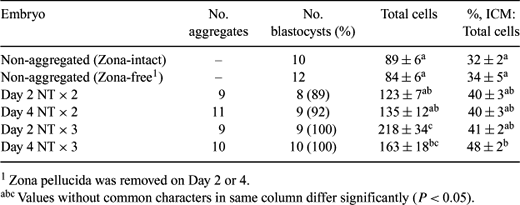25 IN VITRO DEVELOPMENT OF AGGREGATED NUCLEAR TRANSFERRED EMBRYOS DERIVED FROM BOVINE CUMULUS CELLS
S. Akagi A , B. Tsuneishi B , S. Watanabe A and S. Takahashi AA National Institute of Livestock and Grassland Science, Tsukuba, Ibaraki, Japan
B Kochi Prefectural Livestock Experiment Station, Kochi, 789-1233, Japan. Email: akagi@affrc.go.jp
Reproduction, Fertility and Development 17(2) 162-162 https://doi.org/10.1071/RDv17n2Ab25
Submitted: 1 August 2004 Accepted: 1 October 2004 Published: 1 January 2005
Abstract
It has been reported that aggregation of two nuclear transfer (NT) mouse embryos shows an improvement in full-term development (Boiani M et al. 2003 EMBO J. 22, 5304–5312). In this study, we examined the effect of aggregation on in vitro development of bovine NT embryos. As donor cells for NT, cumulus cells of passage 3–5 were used following culture in serum-starved medium for 5–7 days. NT was performed as previously described (Akagi S et al. 2003 Mol. Reprod. Dev. 66, 264–272). NT embryos were cultured in a serum-free medium (IVD-101, Research Institute of Functional Peptide Co., Ltd., Shimojo, Yamagat, Japan). Eight-cell-stage embryos on Day 2 or 16- to 32-cell-stage embryos on day 4 were used for embryo aggregation after removal of the zona pellucida. A small depression was made in a 25-μL drop of TCM-199 with 50 μg/mL phytohemagglutinin (TCM199/PHA) or IVD-101 using a darning needle. Two or three NT embryos were placed into the depression in the drop of TCM199/PHA for 20 min. NT aggregates were then moved into the depression in the drop of IVD-101 and cultured until Day 7. In vitro development of NT aggregates was summarized in Table 1. There were no differences in the cell number and ICM ratio of blastocysts between non-aggregated zona-intact and zona-free embryos. All aggregates of three NT embryos developed to the blastocyst stage and the cell number of these blastocysts was significantly higher than that of non-aggregated NT blastocysts. These results indicate that removal of the zona pellucida does not affect the cell number and ICM ratio of blastocysts and that aggregates of three NT embryos can develop to blastocysts with high cell numbers which are equivalent to in vivo-derived embryos (166 ± 11, Knijn HM et al. 2003 Biol. Reprod. 69, 1371–1378).

|


